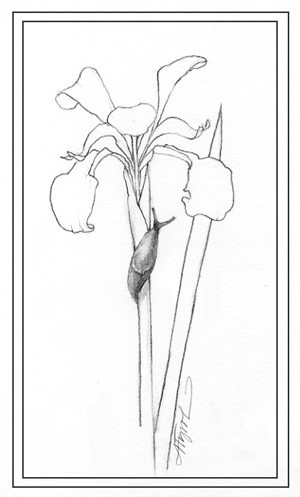
My thoughts turn to gardens, the earthy fragrance of moist woodland – and to slugs tucked under a rock. Few things disturb gardeners so much as slugs and the silvery ribbons of slime they leave behind as evidence of their peripatetic travels.
No one minds an ordinary snail, it seems, but coming across a slug is another matter. Yet snail it is. Many small slug species are shell-less, having forsaken the protection of a shell because of the relative scarcity of calcium in many environments, but the larger slugs found in gardens usually have small internal shells that retain a hint of the spiral shape of their snail ancestors. I have a slug shell in front of me: chalky white, flattened, about a quarter of an inch long, round at one end, and bluntly pointed at the other.
Propelled by waves of muscular contraction passing across the sole of its fleshy foot, a slug glides smoothly upon the slimy, glandular secretion for which it is well known. The mucus lessens friction and makes it possible for a slug (or snail) to skim across rough and unfavorable terrain; it also inhibits fluid loss from the plump body and encourages moisture intake from the soil. As an added benefit, slug-slime is distasteful to predators.
A slug’s mantle, characteristic of all molluscs, looks like a saddle covering the front half of the body. It serves as a protective blanket, taking the place of an external shell. Under the mantle’s right edge, there is a deep hole that opens and closes, serving both as a nostril to the single lung as well as an excretory pore. Also hidden on the right side under the mantle is a genital opening. The slug’s lopsided-ness is a remnant of the creature’s spiral ancestry, when systems had to twist about to make use of the shell’s only aperture.
Two fleshy tentacles on a slug’s head bear eyes at their bulbous tips, each eerily waving around a dark eye capable of forming a good image with lens, iris, and retinal cup. Touch one lightly and the eye retracts into the head as the slender appendage turns outside in.
Another interesting slug experiment: in a dark room, place a strong light behind a slug so that you can see through its translucent skin. You’ll see a three-chambered heart pumping vigorously as blood moves through vessels that empty into spacious cavities; there is no closed capillary network as found in vertebrates.
Inside a slug’s lipped mouth lies an extraordinary toothed tongue that works like a flexible file. Sawed back and forth over plant or animal matter, it rasps off layers of tissue. If the slug is a vegetarian, the tongue cuts leaf cells from between veins, leaving open-rimmed notches. Other slugs are predators, scavengers, or just opportunists grubbing around for anything available. Digestion is rapid, for a slug is always hungry.
Over a half-dozen of North America’s unappreciated slugs are aliens from Europe, now hungrily at home in our vegetable and flower gardens. One of these, the mottled-brown great slug, Limax maximus, has a prodigious appetite for vegetable greens of all kinds and is one of the more commonly found slugs in New Hampshire and Vermont.
Though we usually think of slugs as eaters of our vegetables, slugs are also very much among the eaten. Despite the offensive slime – exuded even more when they are threatened – slugs are devoured by birds, toads, snakes, carnivorous beetles, small mammals, as well as other slugs. As a result, slugs are most active after dark and spend their days hidden away, unless a daytime rain leads to slippery (and therefore favorable) foraging conditions.
I recently found a slug waiting out the daylight hours under a flat stone, far from vegetation. Day after day, the slug would be there whenever I lifted the stone. At night, however, when I lifted up the stone to check on it, the slug would be gone.
Another nocturnal slug undertaking is mating. A single individual is both male and female, so getting together with another slug involves a mutual exchange of sperm. Both will go on to lay eggs, which are small and opaque at first, then increasingly transparent, and laid in bunches of 20 or 30 in the soil and other protected places. When conditions are right, slug populations seem to explode, for an ordinary slug can produce 500 eggs in a single year.
In this contradictory world, there is room enough for even those creatures that creep around in the dark, repelling us with their soft and slimy ways. Except when they’re crawling on the lettuce.

